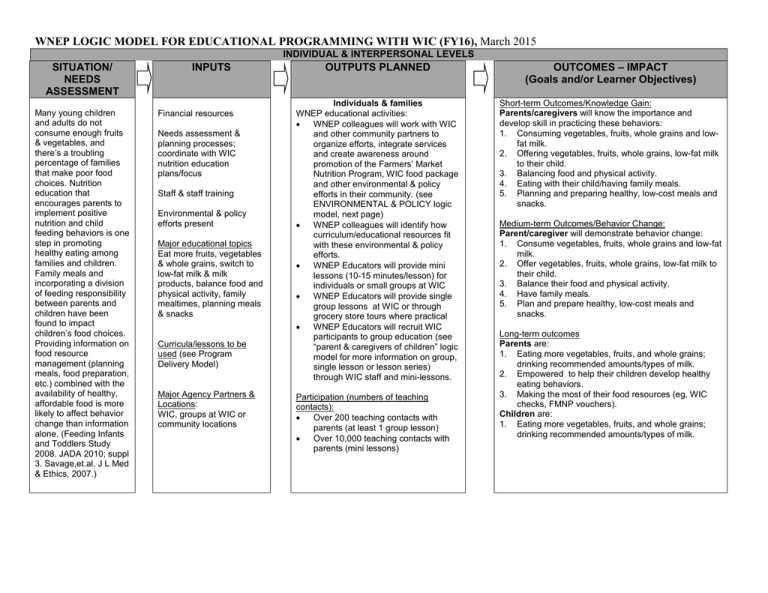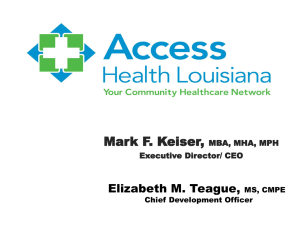Logic Model (FY16)
advertisement

WNEP LOGIC MODEL FOR EDUCATIONAL PROGRAMMING WITH WIC (FY16), March 2015 INDIVIDUAL & INTERPERSONAL LEVELS SITUATION/ NEEDS ASSESSMENT Many young children and adults do not consume enough fruits & vegetables, and there’s a troubling percentage of families that make poor food choices. Nutrition education that encourages parents to implement positive nutrition and child feeding behaviors is one step in promoting healthy eating among families and children. Family meals and incorporating a division of feeding responsibility between parents and children have been found to impact children’s food choices. Providing information on food resource management (planning meals, food preparation, etc.) combined with the availability of healthy, affordable food is more likely to affect behavior change than information alone. (Feeding Infants and Toddlers Study 2008. JADA 2010; suppl 3. Savage,et.al. J L Med & Ethics, 2007.) INPUTS Financial resources Needs assessment & planning processes; coordinate with WIC nutrition education plans/focus Staff & staff training Environmental & policy efforts present Major educational topics Eat more fruits, vegetables & whole grains, switch to low-fat milk & milk products, balance food and physical activity, family mealtimes, planning meals & snacks Curricula/lessons to be used (see Program Delivery Model) Major Agency Partners & Locations: WIC, groups at WIC or community locations OUTPUTS PLANNED OUTCOMES – IMPACT (Goals and/or Learner Objectives) Individuals & families WNEP educational activities: WNEP colleagues will work with WIC and other community partners to organize efforts, integrate services and create awareness around promotion of the Farmers’ Market Nutrition Program, WIC food package and other environmental & policy efforts in their community. (see ENVIRONMENTAL & POLICY logic model, next page) WNEP colleagues will identify how curriculum/educational resources fit with these environmental & policy efforts. WNEP Educators will provide mini lessons (10-15 minutes/lesson) for individuals or small groups at WIC WNEP Educators will provide single group lessons at WIC or through grocery store tours where practical WNEP Educators will recruit WIC participants to group education (see “parent & caregivers of children” logic model for more information on group, single lesson or lesson series) through WIC staff and mini-lessons. Short-term Outcomes/Knowledge Gain: Parents/caregivers will know the importance and develop skill in practicing these behaviors: 1. Consuming vegetables, fruits, whole grains and lowfat milk. 2. Offering vegetables, fruits, whole grains, low-fat milk to their child. 3. Balancing food and physical activity. 4. Eating with their child/having family meals. 5. Planning and preparing healthy, low-cost meals and snacks. Participation (numbers of teaching contacts): Over 200 teaching contacts with parents (at least 1 group lesson) Over 10,000 teaching contacts with parents (mini lessons) Medium-term Outcomes/Behavior Change: Parent/caregiver will demonstrate behavior change: 1. Consume vegetables, fruits, whole grains and low-fat milk. 2. Offer vegetables, fruits, whole grains, low-fat milk to their child. 3. Balance their food and physical activity. 4. Have family meals. 5. Plan and prepare healthy, low-cost meals and snacks. Long-term outcomes Parents are: 1. Eating more vegetables, fruits, and whole grains; drinking recommended amounts/types of milk. 2. Empowered to help their children develop healthy eating behaviors. 3. Making the most of their food resources (eg, WIC checks, FMNP vouchers). Children are: 1. Eating more vegetables, fruits, and whole grains; drinking recommended amounts/types of milk. WNEP LOGIC MODEL FOR EDUCATIONAL PROGRAMMING WITH WIC (FY16), March 2015 INPUTS Major Agency Partners & Locations: WIC, Public Health, grocery stores, farmers’ market vendors, policy/decision makers ENVIRONMENTAL & POLICY LEVELS OUTPUTS PLANNED Efforts to increase partnerships and interconnectivity among partners Efforts to identify opportunities Local, State and Federal policies: Dietary Guidelines for Americans Healthy, Hunger-free Kids Act, WIC food package Farm bill, farmers’ market nutrition program Food & beverage marketing and media regulations Existing efforts in community: Policy & environmental changes in WIC Coalition work in community Opportunities in community (e.g., access to healthy, affordable food, opportunities for safe, affordable physical activity for families) Other Cooperative Extension work in community (eg, financial literacy or parenting efforts, Master Gardeners, urban/community planning, local foods) Tools Food challenge simulation and other PACE tools to raise awareness of poverty, food insecurity and health equity Needs assessment & planning processes Evaluation and monitoring processes Training, technical assistance and resources/tools from state partners (eg, State Specialists, state agencies) Financial resources: Grants, local businesses, etc. Established community-wide common agenda and goals around key messages: Increase consumption of fruits, vegetables, whole grains, low-fat milk Increase physical activity and decrease screen time Maintain appropriate calorie balance during each stage of life Efforts to increase awareness of poverty and health equity, and reduce disparities in access to healthy, safe, affordable food and safe, affordable opportunities for physical activity Monitoring and evaluation of efforts OUTCOMES – IMPACT (Goals and/or Objectives) Short-term Outcomes: Stronger partnerships and interconnectivity among partners. Increased awareness of nutrition, food security obesity prevention priorities. Medium-term Outcomes Increased number of policy, systems and environmental changes that support families with lowincome in choosing healthier food and beverages, and being more food secure. Increased number of policy, systems and environmental changes that support families with lowincome in being more physically active. Increased number of families with low-income reached with policy, systems and environmental changes that support families choosing healthier food and beverages, and being more food secure. Increased number of families with low-income reached with policy, systems and environmental changes that support families to be more physically active. WNEP LOGIC MODEL FOR EDUCATIONAL PROGRAMMING WITH WIC (FY16), March 2015 EVALUATION QUESTIONS (What do you want to know and How will you find out?) Indicators for short-term outcomes [single lesson or mini lesson] Number, or %, of WIC participants reached who report intent to: Make at least half their plate fruits and veggies. Try something they learned from lesson to eat more whole grains. Choose foods and drinks with little or no added sugars. Try something they learned from lesson to plan and prepare healthy, low-cost meals and snacks. Try something they learned from lesson to help their child develop healthy eating habits. Indicators for Medium-term Outcomes for Community Coalitions/partners working with WNEP Number of WNEP colleagues who report working with coalitions/partners to develop and implement environment and/or policy changes that make healthful food and physical activity practices for WIC participants easier/more affordable.




